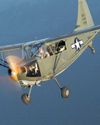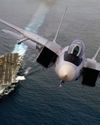Prøve GULL - Gratis
YELLOW SCORPIONS - P-51 Mustangs rule the skies in China
Flight Journal
|January - February 2021
Using Chinese airfields, the 311th Fighter Group was the first to take World War II to the Japanese. The 311th’s 530th Fighter Squadron, which became known as the “Yellow Scorpions,” was the first squadron based in China. During their combat tour, they flew A-36 dive bombers along with all versions of the P-51 (A, B, C and D). However, it was their expertise with P-51 B and C models that earned them the respect of Japanese pilots.
The pilots of the 530th were formidable. They flew long distances to engage enemy forces and handed out more than the Japanese could handle, with huge victories over enemy airmen who were only a few minutes from their home base. During one early mission, gunners on the bombers had trouble identifying the Mustangs from the opposing forces, so the 530th decided to paint their prop spinners yellow. That solved the problem because from that time on, the gunners on the bombers were sure they were friendly to the yellow-nosed fighters. The squadron’s outstanding kill ratio gained them a lot of publicity from “Tokyo Rose,” and in her broadcasts, she referred to them as “Yellow Scorpions.” The moniker stuck for the duration of the war.
“The Tojo whipped over, trailing a long plume of flame ...”
On October 21, 1943, the Group launched eight aircraft along with four Mustangs from the 530th on a big Japanese supply dump at Kamaing in Burma. The enemy wasn’t ready to take them on, and the target was completely destroyed. This triggered many raids in central and southern Burma. While the Allied aircraft were ready for any resistance in the air, they concentrated on ground targets such as rail centers and supply dumps. The 530th squadron’s P-51As met numerous Mitsubishi Zeros when they accompanied B-24s and B-25s on bombing missions.

On Thanksgiving Day, 1944 the squadron flew their longest mission to date, all the way to Rangoon, Burma. They were briefed to rendezvous with B-24s south of Akyub and refuel at a primitive strip at Ramu that had no outside communications. That flight was led by squadron Operations Officer Captain James J. England, and he describes what happened.
Denne historien er fra January - February 2021-utgaven av Flight Journal.
Abonner på Magzter GOLD for å få tilgang til tusenvis av kuraterte premiumhistorier og over 9000 magasiner og aviser.
Allerede abonnent? Logg på
FLERE HISTORIER FRA Flight Journal

Flight Journal
ELLIPTICAL ELEGANCE
Flying and evaluating the Seafire Mark III
4 mins
November - December 2025

Flight Journal
IRON DOG
Fighting the Pacific and the P-39 at the same time
14 mins
November - December 2025

Flight Journal
Fighter Pilots: A Warrior Clan
TAKE A HARD LOOK at the two young men in these photos. Do they look as if they were bent on killing one another? On the left we have a young, unknown enlisted Japanese pilot standing in front of a Nakajima Ki-27 \"Nate,\" one of Japan's earliest monoplanes that led to the much vaunted Zero.
3 mins
November - December 2025

Flight Journal
KEN WALSH THE FIRST CORSAIR ACE
Medal of Honor pilot's combat adventures
12 mins
November - December 2025

Flight Journal
Big Chief's Little Chief
Thunderbolt action with the Wolf Pack
11 mins
November - December 2025

Flight Journal
ENEMY PILOTS SPEAK Voices from the other side
All too often American students of air warfare forget that enemy aircraftwhether Messerschmitts or MiGs-were flown by human beings with the same motivations and traits as Allied airmen. More often than not, the only difference between friend and foe was the paint on the airplane and where they landed. Therefore, we've assembled a variety of accounts from WW II Axis fighter pilots, men who were more than simply targets.
11 mins
November - December 2025

Flight Journal
FLYING THE FW 190
A legend gets checked out in the Butcher Bird
15 mins
November - December 2025

Flight Journal
DOUBLE-THEATER ACE
The fearless missions of legendary fighter pilot Col. John D. Landers
12 mins
November - December 2025

Flight Journal
WARBUG IN THE PACIFIC
Surviving combat in a Stinson OY-1/L-5
10 mins
September - October 2025

Flight Journal
WINGS OF THE FLEET
Celebrating the U.S. Navy's 250-year legacy
9 mins
September - October 2025
Translate
Change font size

